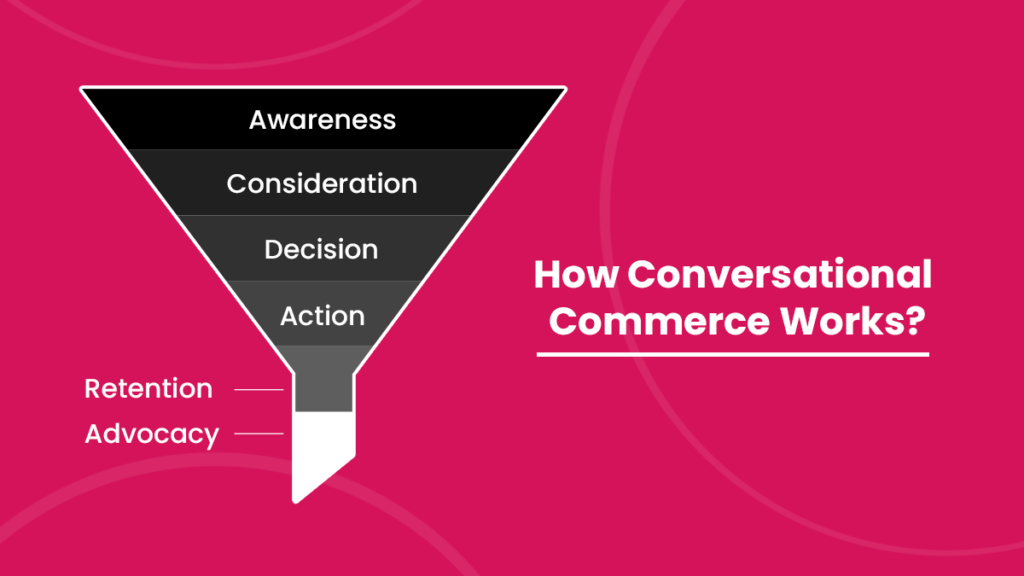
Conversational commerce is a recent marketing strategy that involves direct interaction between brands and customers via online Chat commerce.
To increase sales and customer lifetime value, Conversational commerce platform typically uses conversational AI technology, such as chatbots, live bots, etc. However, some companies also use live agents to give their communications a more individualized touch and to offer highly qualified assistance.
This interactive strategy aims to give the world of eCommerce a human touch. It is comparable to having a talkative, knowledgeable salesperson at a physical store behind the counter. But everything occurs online.
Utilizing this technology can help you respond to customer inquiries, streamline transactions, or introduce your products. It’s a crucial method for assisting customers in locating what they need quickly.

Conversational definition improves a company’s ability to connect with customers at each stage of its purchasing journey by putting the customer and company in direct contact via various channels. It works by utilizing conversation through Chat commerce and messaging and, in some cases, automation to assist a customer through the customer journey.
In the customer journey, awareness is the first phase. At this stage, conversational commerce aims to establish contact with the consumer and to introduce or reestablish your brand’s reputation and presence. Knowing their customers’ wants is a trait of the most successful brands. And expectations, so they can fulfill these expectations when purchasing.
At this stage, consumers become more informed about their needs and ask for product information via search engines and direct inquiries (for example, by phone). Conversational commerce helps you complete a sale by providing detailed product information that consumers need to move to the next stage.
In the next step, consumers make an informed decision about their purchase. During this phase, conversational commerce can help you with product search and purchasing decisions and convert those customers into lead generation.
During this stage, companies should focus on building lasting customer relationships. Conversational commerce can help you retain and convert these customers by providing customer service and engaging them in conversations specific to the customer experience.
In the final step, the customer is an advocate for the company and continues to communicate with the business using a variety of platforms, including social media and email, or even in person or by telephone. Conversational commerce can help you capture this opportunity by strengthening your brand loyalty strategies and new customer acquisition efforts.
There are many advantages to conversational commerce, and it is obvious how it can help your company increase conversions and customer loyalty. But what specific kinds of conversational commerce platforms are available? Which one is appropriate, given the objectives you have for this tactic?
Live chat is one of the most basic and commonly used types of conversational commerce. Think of a conversation between an agent from your company and a customer. The agent would typically provide solutions to your customers’ questions, create a dialogue based on each client’s individual needs, and answer any concerns that arise.
Live Chat commerce uses a standard interface, Alternatives to Software, available with buttons representing different topics. (for example, product information, purchase status, etc.). When someone contacts you via live chat software, they typically will be presented with this list of topics once they type in their question or concern.
Chatbots are artificial intelligence that allows customers to interact with your company through a Conversational business. They work similarly to live agents, but the AI can respond more quickly. Chatbots can also hold more complex conversations by using natural language processing.
You must be careful when planning your chatbot strategy. An effective chatbot must answer all questions in a very specific and professional manner as if it has mastered common knowledge.
The most successful chatbots should go beyond just responding with information, however. They should make customers feel involved and Speed up your store by showing how much they care about their satisfaction.
Messaging apps are similar to social media applications because they allow customers to interact with your company through instant messaging and voice chat. Individuals may be utilized for several purposes, including offering information about the product or consumer assistance.
The most popular messaging apps like WhatsApp, Facebook Messenger, and Skype allow you to send and receive text, video, and voice calls using their application. Each has a different approach to Conversational shopping for customers who need information about purchases or specific customer support issues.
Voice assistants, such as iPhone’s Siri and Amazon Echo, are devices that allow digital assistants to assist customers with their purchases. Voice assistants can be digital translators between your company and its customers.
They can help you respond to questions or concerns by gathering information from your business website or other information sources to provide an answer.
The voice assistant platform is very similar to the instant messaging platform. Still, it has a more advanced user interface that allows customers to speak naturally rather than letters simultaneously as you type words.
Conversational commerce gives brands an effective tool for communicating in a personalized and on-brand manner. This will increase customer satisfaction and your chances of making a sale. Here are all of the key advantages you should be aware of:
There is a strong correlation between buyer satisfaction and the number of products sold. Satisfied customers tell others about their satisfaction, leading to more sales and word-of-mouth marketing.
Conversational commerce can give you the tools you need to optimize the buying experience. Customers will be more satisfied because they feel like they have been involved in the decision-making process and have been given personalized information relevant to their needs.
The most popular advantages of conversational commerce are that it is much faster and more efficient than traditional eCommerce. Conversational selling can Improve eCommerce customer experience through advanced virtual assistants that use artificial intelligence to answer questions and resolve customer problems.
This will make customers feel comfortable asking you questions more relaxed, and they will also be able to ask more specific questions. With this customer-focused focus, it is easier for your company to create an emotional connection with its customers and help drive more traffic.
Many conversational commerce platforms have built-in chatbots that allow you to provide customer service and collect data for a small portion of the price of hiring new employees. This will increase your potential benefits and make it easier for your company to scale as a business.
The responses that chatbots provide to certain inquiries or tasks can be programmed, making it impossible for them to answer questions incorrectly or forget specific tasks, increasing your chances of receiving positive customer reviews. Technology is constantly improving, so the more you invest in this outlet now, the more you will benefit in the future.
Conversational commerce will give brands the ability to interact with customers in a more personal manner. You can provide a wide range of services such as product delivery reminders, an invitation for sales, and help during the buying process to increase customer satisfaction.
This eCommerce channel will also allow you to interact with customers at any time of the day. You can provide customer service at any hour of the night or during any holiday or weekend without having to hire additional staff. For instance, if a client has a query regarding your business during their vacation or in the middle of the night, they can easily make a voice call using an AI-powered assistant.
Conversational commerce platforms give customers the ability to provide feedback to your company with a detailed survey. This will allow you to gather more customer data, which can help you track customer satisfaction levels, process orders more efficiently, and improve your brand.
The AI-powered chatbots will analyze this data in real-time and make adjustments based on the responses before replying. This potentially leads to deeper customer relationships, which can lead to loyalty.
We specialize in Conversational Commerce and don’t charge for consultation calls. Give us a call for some free advice and detailed insights!
Many brands have tried conversational commerce and have failed because of a lack of understanding of how to automate the messaging. To be successful with Conversational shopping, you need to know how to use customer support tools such as chatbots and AI-powered assistants.
The first step in conducting conversational commerce research is to create a list of all the potential chatbots available on the market. You then need to conduct intensive research about each chatbot platform and the tools available with those platforms.
Each platform has specific features, so you must research them carefully before making a final decision. Know your competitors: Your competitors are likely using this type of software; therefore, be prepared to address any queries or worries you may have regarding their usage of conversational commerce.
This is the most crucial step in the process of using conversational commerce. Once you have defined your needs for customer support, you need to use computer vision and natural language processing tools to analyze the goal of the customer.
A chatbot cannot respond to specific questions if it is not programmed with information about your products, services, pricing, and shipping options. That would be beneficial if you also developed a strategy for how you would respond if a client had a query that your chatbot was unable to answer.
The result of the extensive research you conducted will provide you with a list of chatbots to use for your conversational commerce. You then need to ensure that the chatbot is fit for your needs. One of the easiest ways to do this is by outsourcing your customer support completely.
You can outsource this function to an agency with a team of customer support experts, such as Virtual Assistant and Virtual Personal Assistant (VPA). These companies have been established for some time and have many customers who use their services.
Once you have your list of chatbots and decide which platform is best for your business, the next step is to launch your conversational commerce tool. You can do this by contacting a platform provider to help with the development process.
You will need help during this process’s setup, programming, and Integrate phases. Be aware that many factors can affect these tasks, such as: What platforms will be used (Facebook Messenger or Slack)? How frequently will the chatbots need to be updated? How skilled are you in IT?
After creating your chatbot, you must evaluate its Success. You will need to track various metrics such as the number of chats, messages sent and received, the number of questions answered by the chatbot, and the number of satisfied customers.
Tracking these metrics aims to determine if your chatbots are working as intended or if you need to make changes or adjustments. It is also crucial for you to measure customer satisfaction at the end of each month.
Conversational commerce will be an excellent way for brands to interact with their customers in previously difficult ways. The technology provides a more personal experience and allows consumers to ask questions, share feedback, and make purchases without leaving their current product or service environment.
As Conversational commerce platforms become more popular, brands need to remain on the cutting edge of this technology by creating an e-commerce website. They need to invest in the best customer service tools and be prepared to respond at any moment of the day to serve their clients. A strong understanding of the conversational commerce tools available is an excellent way for brands to begin using this innovative and fascinating technology.